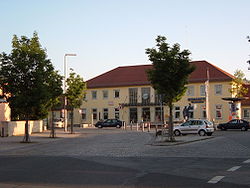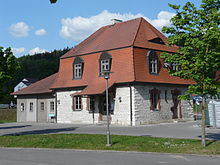Neumarkt – Dietfurt railway line
| Neumarkt (Oberpf) –Dietfurt (Altmühl) | |||||||||||||||||||||||||||||||||||||||||||||||||||||||||||||||||||||||||||||||||||||||||||||||||||||
|---|---|---|---|---|---|---|---|---|---|---|---|---|---|---|---|---|---|---|---|---|---|---|---|---|---|---|---|---|---|---|---|---|---|---|---|---|---|---|---|---|---|---|---|---|---|---|---|---|---|---|---|---|---|---|---|---|---|---|---|---|---|---|---|---|---|---|---|---|---|---|---|---|---|---|---|---|---|---|---|---|---|---|---|---|---|---|---|---|---|---|---|---|---|---|---|---|---|---|---|---|---|
|
Neumarkt train station in the Upper Palatinate
| |||||||||||||||||||||||||||||||||||||||||||||||||||||||||||||||||||||||||||||||||||||||||||||||||||||
| Route number (DB) : | 5930 | ||||||||||||||||||||||||||||||||||||||||||||||||||||||||||||||||||||||||||||||||||||||||||||||||||||
| Course book section (DB) : | 871 (1987) | ||||||||||||||||||||||||||||||||||||||||||||||||||||||||||||||||||||||||||||||||||||||||||||||||||||
| Route length: | 37.0 km | ||||||||||||||||||||||||||||||||||||||||||||||||||||||||||||||||||||||||||||||||||||||||||||||||||||
| Gauge : | 1435 mm ( standard gauge ) | ||||||||||||||||||||||||||||||||||||||||||||||||||||||||||||||||||||||||||||||||||||||||||||||||||||
|
|||||||||||||||||||||||||||||||||||||||||||||||||||||||||||||||||||||||||||||||||||||||||||||||||||||
The Neumarkt – Dietfurt line was a branch line in Bavaria . It ran from Neumarkt in the Upper Palatinate southwards along the Sulz , which earned it the name Sulztalbahn, largely parallel to the Ludwig-Danube-Main Canal to Beilngries and from there along the Altmühl to Dietfurt . Only a short section is still in operation today, which serves as a connecting line for an industrial company in Sengenthal . In July 2020, the Neumarkt – Beilngries – Kinding railway lines (connection to the high-speed railway line) were included in the VDV's position paper as railway lines to be reactivated.
history
When the Regensburg – Nuremberg railway line was completed in 1873, there were already plans to connect the communities between Neumarkt and Eichstätt to the railway. Different variants were discussed, including routes to Breitenbrunn and Kelheim , but these were soon discarded. In 1886 the plans were concretized and the construction of a line Neumarkt – Beilngries – Dietfurt an der Altmühl began. In Greißelbach a line should branch off to Freystadt , in Beilngries the line should meet the Altmühltalbahn from Eichstätt station.
On June 1, 1888, the Neumarkt – Beilngries section including the Greißelbach – Freystadt branch (popularly known as the “Lerzerbahn” ) was opened, and the extension to Dietfurt an der Altmühl was released on September 11, 1909. Initially, the route was very successful in freight and passenger traffic, and it also came into direct competition with the Ludwig Canal, which ran parallel, and ultimately contributed to its economic decline. With the increase in individual motorized traffic, however, their existence was soon threatened. On July 31, 1966, passenger traffic was stopped on the Dietfurt – Beilngries section; on May 26, 1967, this section was shut down and dismantled in 1968.
With the construction of the new Main-Danube Canal between Bamberg and Kelheim, the end of the Neumarkt – Dietfurt railway was finally heralded: the line, especially with Beilngries station, was in the way of the major project. On September 25, 1987 the last passenger train ran between Neumarkt and Beilngries, freight trains in the Greißelbach – Beilngries section until July 29, 1989. Between August 28, 1989 and November 30, 1989, the line to the south of the Greißelbach station was dismantled, only the section Neumarkt – Greißelbach temporarily remained in operation as a branch line. At the end of October 31, 1991, this remainder of the branch line was also shut down and the tracks dismantled up to approx. 5.5 km. The remaining track was downgraded to a station siding and the Max Bögl company siding was built. In the course of the construction of the connection, the accident-prone Fischerhäusl curve of the B 299 was defused and a new north access to the plant (Gate 3) was created. On January 1, 2005, the siding was taken over by the Max Bögl company. Since then, the volume of freight has increased. The connection is operated daily. Since 2011, the Tchibo central warehouse in Neumarkt has also been supplied with containers via the siding, which are then transported by truck. At the beginning of 2016, the superstructure was renovated on this remaining stretch and new rails were laid.
Route description
The line leaves Neumarkt station in a southbound direction and first crosses Ingolstädter Straße. It then leads through the industrial area south, where there is a plant connection to Pfleiderer AG , and past the Hasenheide district. Here it leaves the Neumarkt urban area and leads through the Missholz. Then Sengenthal is reached, where there is a former stop with an existing Schüttbahn platform. The nearby inn, which once housed a waiting room for passengers, has now been demolished. The route continues on the former B 299 to the Schlierferheide industrial park, where today the route leads to the Sengenthal plant (Gate 3) of Max Bögl GmbH at km 5.8 . The actual route towards Beilngries is dismantled from here.
Originally there was another level crossing over the B 299 here, the route then ran along the federal road to shortly before Greißelbach, where it again crossed the federal road and also the Ludwig Canal and then reached the old Greißelbach train station. The station building including the annex has been restored. The former station area in Greißelbach now serves the owner, the Bögl Group, as an innovation center, where the company's own track products are exhibited: various slab track systems, a segment of a high-speed switch, a Transrapid track girder and, recently, even a segment ring. A part of the Transrapid TR 07 train, which originally did its laps on the test track in Emsland, and the steam locomotive 98 507 (on loan from the city of Ingolstadt), which was the last steam locomotive of the 98.4–5 series ( Bavarian D XI ) between Greißelbach and Freystadt was used in passenger train traffic until 1960 and is popularly known as the "Freystädter Bockel". The Greißelbach station once had three tracks, while track 2 was the main track in the direction of Beilngries, the branch line branched off from track 3 to Freystadt (Oberpf). The route continued south, crossed the B 299 again and ran between the main road and the canal. It now reached Mulhouse. The route then swiveled to the southeast, passed the old station in Mühlhausen (Sulz) and led to the Ludwig-Danube-Main Canal, which it now followed in parallel. Shortly before Pollanten, the B 299 was crossed again and shortly afterwards the Pollanten stop was reached. The canal, railway line and main road now ran right next to each other and led into the Sulz valley.
The station with its three tracks was at the entrance to Berching. In the station there was also a siding to the flax roasting branch . The route ran a little way along the city wall of Berching and followed the Ludwig-Danube-Main Canal.
The route now led through Plankstetten, where there was another stop. Another level crossing followed south of Plankstetten, and the route now ran alongside the main road and canal. After passing Gösselthal - the Ginter junction (PA Ginter) was located here - the route finally reached Beilngries. There were two train stations here, the passenger station from 1929 (branch station of the branch line to Eichstätt ) and a little further the freight station from 1888. Of these, the former station building still exists today in the immediate vicinity of the Rhine-Main-Danube Canal, all of them other railway buildings, including the engine shed, were demolished in the course of the canal construction.
The Neumarkt – Dietfurt railway ended in the Altmühltal to the east and followed the valley at the foot of the northern slope. There was another stop on the northern outskirts of Kottingwörth, as well as in Töging. The line now swiveled to the northeast, crossed the Ludwig-Danube-Main Canal a second time and led into the urban area of Dietfurt (Altmühl), where the terminus was located.
Current condition
Except for the 5.8 km long section from Neumarkt (Oberpf) train station to the factory premises, which is still in operation, the line has been completely dismantled. In large parts of the terrain, however, the course of the railway lines can still be clearly seen today. Many sections of the route now run along the former track bed. Some station buildings from this time are still preserved, as far as they were massive stone buildings and not the wooden agency buildings typical of the Bavarian local railways, for example in Greißelbach, Berching and Beilngries. The station building in Greißelbach belongs to the Max Bögl company and was renovated by them for presentations.
The remainder of the line, which is now operated as a siding by Max Bögl, now runs alongside DB locomotives as well as the company's own shunting locomotive V 60 608 (former DB 360 608). Passenger trains have also been running on the old railway line recently: on October 10, 2010, the Franconian Museumseisenbahn e. V. (FME), on May 27, 2012 a 2-part rail bus set as part of a special trip by IBSE e. V. and on March 31, 2013 the steam locomotive 52 8195 with the FME museum train as "Easter Express".
A replica of the previous station board has been standing at the former Sengenthal stop for some time.
The anniversary "125 years of Sulztalbahn" was celebrated on June 2, 2013 with a steam shuttle ride on the remaining track section and a station festival at the former Greißelbach station. In view of this anniversary, the track field in front of the factory gate was given the name “Schlierferheide Station” and a “SCHLIERFERHEIDE” station board was set up here, based on the earlier station boards of the Sulztalbahn.
In 2016, 386,000 tons were transported on the route to Sengenthal. Extensive maintenance work was carried out this year.
literature
- Ulrich Rockelmann: Searching for traces of dismantled railway lines in the Nuremberg area . Hofmann Verlag Nürnberg, Nürnberg 1999, ISBN 3-87191-270-0 .
- Christoph Meier: Concrete Railway, 125 years of the Sulztal Railway. In: eisenbahn magazin 6/2013, pp. 22-25, Alba Publications, ISSN 0342-1902
- Christoph Meier, branch line Neumarkt - Beilngries , Neumarkt idOPf. 2013, ISBN 978-3-00-042576-9
Web links
- Website with details about the history and numerous photos (private)
- Website with numerous photos of the route and the parallel Ludwig Canal
- Website of the "Eisenbahnfreunde Sulztalbahn"
Individual evidence
- ↑ Railway Atlas Germany 2007/2008 . 6th edition. Schweers + Wall, Aachen 2007, ISBN 978-3-89494-136-9 .
- ^ VDV: reactivation of railway lines. Retrieved August 5, 2020 .
- ↑ eisenbahn-magazin 6/2013, pp. 22-25
- ↑ Max Bögl-Bahn completely renovated . In: railway magazine . No. 6 , 2016, ISSN 0342-1902 , p. 19 .
- ↑ Max Bögl's “Betonbahn” has been running for 25 years. In: nordbayern.de. Neumarkter Nachrichten , January 29, 2017, accessed on May 14, 2018 .


